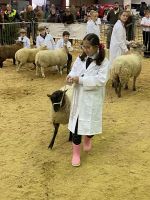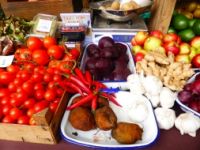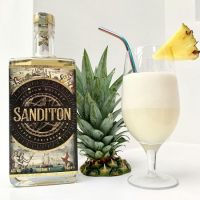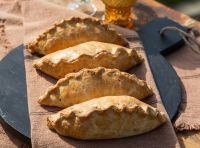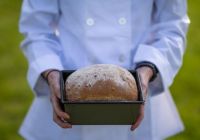We have two elderly heirlooms here at Local Food Britain HQ (and no, one of them isn’t me). The bureau from my parents’ house, worn from years of use, its sliding glass doors still rattling reassuringly in that way they did all those years ago each time Dad closed the desk. On top of the bureau stands a slightly shabby book. It belonged to my grandmother and is dated 1936. Written by Elizabeth Craig - one of the most notable writers on British cookery of the 20th century - it’s entitled ‘Cookery Illustrated and Household Management’ - and the yellowed pages reveal a fascinating insight into a bygone era. Now in a very delicate state after nearly 80 years of use, its 750 pages are packed with recipes and advice and, under ‘M’ in the index, after ‘Mice (to Get Rid of)’ and Milk (Importance of) comes ‘Mutton’, for which there are no less than 32 entries. From braised mutton to mutton fritters, mutton pies and even mutton tea, it’s all there.
Fast-forward to 2014, and that much-prized mutton is now considered a forgotten food. The product of a sheep aged between two and five years old (although there is no legal definition), this meat has somehow slipped from our daily menus, replaced by tender, yet somewhat less flavoursome, lamb. Interestingly, Elizabeth Craig’s book has only eight entries under ‘Lamb’, and one of those is for Lamb’s Head Broth, the prospect of which is unlikely to set the modern family’s tastebuds tingling.
So, what happened to mutton? Where did it go?
In search of answers, I arrange to speak with the expert, Bob Kennard, author of “Much Ado About Mutton”, who I have heard talking on BBC Radio 4’s Food Programme. In his book, published by Merlin Unwin, Bob unravels some of the mysteries and says he believes mutton is now poised to make a come-back.
But where did it go in the first place?
In Victorian times, mutton was the food of kings and paupers alike, yet things started to change when New Zealand and Australia found themselves with too many sheep as a by-product of the thriving wool industry. Once refrigeration came into being in the late 19th century, the solution was obvious – ship the meat to Britain to feeds its hungry and growing population. This was the beginning of the end for British mutton and by 1925 lamb was beginning to appear more and more on our menu. It may not have had the depth of flavour of mutton, but this younger meat was more reliable, even in the hands of the careless cook.
Also influencing the decline in mutton consumption was the introduction of synthetic fabrics to replace wool. The lower demand for wool in the 1960s saw the price take such a tumble that it barely covered the cost of shearing, which in turn reduced the number of mature sheep going into the meat market.
Chatting to Bob, I say I think there’s a quite a big PR job needed to reinstate mutton to its worthy place in the hearts and stomachs of the British population, as many consumers mistakenly assume that mutton is tough as old boots. Certainly, my childhood memories from the 1970s are that lamb was the luxury meat and mutton, well, I don’t recall anyone admitting to serving it back then, though they probably did and passed it off as particularly flavoursome lamb.
“There is a certain folklore about it being tough, a notion left over from the War when not much meat was around and what was available wasn’t always so good,” Bob admits good-naturedly. “If you slow cook it you can’t go wrong with mutton. You get reliable and fantastic results no matter what cut you choose.”
So it seems Elizabeth Craig was on the tail end of mutton’s popularity in her book published just three years before the outbreak of World War II, though I’m sure her recipe for Lamb’s Head Broth was keenly enjoyed in those austere years.
Bob goes on to tell me that mutton has “extraordinary health benefits”, citing what he refers to as “absolutely fascinating work” into the importance of balancing the body’s levels of Omegas 3 and 6.
In his book he says, “Recent Australian research has shown that when compared to a wide range of other meats (pork, beef, veal, chicken and lamb), mutton contains a higher level of Omega-3 fatty acids than all the other meats tested. Only fish was shown to have higher levels, particularly oily fish. Omega-3 levels in mutton were 40% higher than in lamb, 60% higher than beef, six times that in chicken, and 11 times that found in pork.”
With so much going for it, I’m pleased to hear that Waitrose and Booths are bringing back mutton and I’m sure there’s not a butcher in the land who wouldn’t happily muster up whatever part of the senior sheep’s carcass we so desire, but is all mutton pretty much the same?
“No, it’s not,” says Bob, explaining that the book illustrates the different cuts. “Personally, I think you can’t go wrong with leg if you want to roast it long and slow, or get the butcher to dice a shoulder and cook it all day in the slow cooker; lots of butchers, farm shops and farmers markets sell diced shoulder now.”
As with all meat, breed and husbandry are important.
“The Victorians were passionate about their mutton and would have known the best breeds,” Bob continues. “There are three main groups: Uplands, which include Welsh, Scottish and Herdwick in Cumbria and Northern England; Downlands from the South Downs and other chalk downlands; then the Primitives, from isolated regions such as the Western Isles of Scotland.”
Roaming and foraging produce better meat and less fat so, as you would expect, the animal’s diet is key, and Bob explains that mutton sheep should be pasture fed where the grass and vegetation is wild and varied, “ideally on top of a hill, but not necessarily so on the chalklands of South of England.”
Having checked the breed and diet of the animal, there are two other important considerations. The age of the ewe, which as we’ve heard can be anything between two and five years old, and whether it has been hung (two weeks is about right, though it can be longer).
It’s quite a lot to think about, and this is where a good butcher comes in, like the ones listed here on Local Food Britain. They will be able to reassure you about the animal’s provenance and help you choose the best cut for your recipe.
I say to Bob that a badge would be really helpful for consumers to identify the quality of the meat. He agrees but says he feels that is some way off due to the costs involved in developing and introducing a standards scheme.
Meanwhile, best avoided for fail-safe cookery is so-called ‘cull ewe meat’. This comes from ewes which have outlived their ability to produce lambs and are, to put it bluntly, disposed of in the mass market. Much of this meat goes to the processing industry and re-appears in ready meals, burgers and suchlike. It’s sold and bought on price, not quality.
“Cull ewes’ meat is bog standard,” says Bob. “To build up real quality, maybe the farmer would need to keep the ewes a bit longer to produce more finished, better shaped animals. This may involve bringing them down to lower pastures to put on more meat and develop the flavours.”
It’s pretty obvious why many farmers are opting out of this finishing stage of the cycle. There isn’t the demand (yet) for mutton and it’s simply not worth the farmer’s investment if he can’t get a fair return for this superior meat.
Bob believes change is coming and the positive effects could touch lives.
“I live in an upland area in mid Wales,” he explains, “and the way I look at it, it’s important because upland livestock farmers have a difficult time as they don’t know what they will get for their sheep until they come to sell. I’d like to help bring some stability into the upper quality ewe market by getting the farmers a premium for really good mutton as opposed to cull ewes. That would make a real difference to these farming communities.”
Bob Kennard is doubtless a man on a mission. So, are farmers are behind him?
“Yes, I believe so,” he responds thoughtfully, “and we have the support of The Mutton Renaissance Club [whose patron, The Prince of Wales, provided the foreword for ‘Much Ado About Mutton’] and the National Sheep Association.”
So, I ask, what next for mutton?
“Well, we just want to popularise it,” he replies. “Make it the norm to have good quality mutton down the pub and buy it at the local shop and enjoy it for it is, which is a fantastic meat.”
Wouldn’t it be good to bring this great British staple back onto our daily menus?
Proud, flavoursome marvellous mutton.
Bob, here at Local Food Britain, we’re behind you all the way, and we’re sure the mighty Elizabeth Craig would be too!
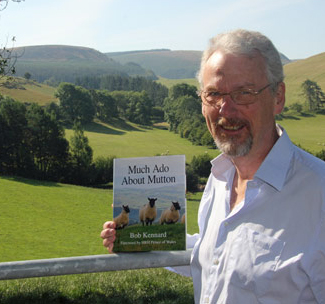
Signed copies of 'Much Ado About Mutton' are available from www.MuchAdoAboutMutton.co.uk
Photos on this page are copyright Bob Kennard
Tags: mutton
Bob Kennard





